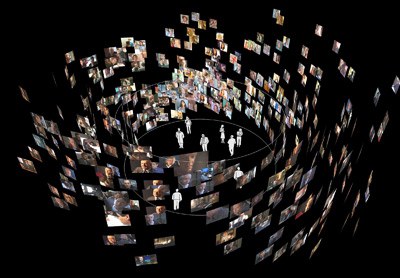Video
T_Visionarium (AKA Project TVisionarium Mk II)
Thu, 10/01/2008 - 11:35 — balintThis series of pages summarises the contribution I made to TVisionarium Mk II, an immersive eye-popping stereo 3D interactive 360-degree experience where a user can search through a vast database of television shows and rearrange their shots in the virtual space that surrounds them to explore intuitively their semantic similarities and differences.
It is a research project undertaken by iCinema, The iCinema Centre for Interactive Cinema Research at the University of New South Wales (my former uni) directed by Professor Jeffrey Shaw and Dr Dennis Del Favero. More information about the project itself, Mk I and the infrastructure used, is available online.
I was contracted by iCinema to develop several core system components during an intense one month period before the launch in September of 2006. My responsibilities included writing the distributed MPEG-2 video streaming engine that enables efficient clustered playback of the shots, a distributed communications library, the spatial layout algorithm that positions the shots on the 360-degree screen and various other video processing utilities. The most complex component was the video engine, which I engineered from scratch to meet very demanding requirements (more details are available on the next page).
Luckily I had the pleasure of working alongside some wonderfully talented people: in particular Matt McGinity (3D graphics/VR guru), as well as Jared Berghold, Ardrian Hardjono and Tim Kreger.

Reversing My Motion Vectors
Mon, 07/05/2007 - 18:40 — balintTo more carefully study the effects of reversing motion vector directions, I created a 'control' video of me making particular motions at different speeds. You can witness the results:
Mashed up: The Matrix - Reloaded
Mon, 07/05/2007 - 18:38 — balintThe following snippet of the Burley Brawl from The Matrix: Reloaded has been passed through my hacked version of libavcodec to reverse the direction of each motion vector:
libavcodec & ffdshow
Mon, 07/05/2007 - 18:34 — balint
To perform these experiments, I needed to be able to tweak the source code of a video decompressor. Since I do most of my development on the Windows platform using Visual Studio and I wanted to support as many codecs that use motion compensation, my options became limited. libavcodec in ffmpeg is the library to encode and decode any of a host of video and audio codecs. There is one catch however: it is written in C using C99 features and VC does not compile C99. Therefore I (back-)ported libavcodec to the Windows platform so I could use a GUI debugger and quickly learn the structure of the code. This would allow me to make quick changes and evaluate the results.

